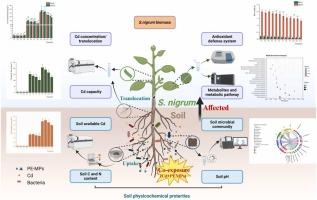Effects of polyethylene microplastics on cadmium accumulation in Solanum nigrum L.: A study involving microbial communities and metabolomics profiles
IF 12.2
1区 环境科学与生态学
Q1 ENGINEERING, ENVIRONMENTAL
引用次数: 0
Abstract
Combined pollution with heavy metals and microplastics (MPs) is widespread in farmland soil, and MPs can affect the efficiency and capacity of cadmium (Cd) uptake by hyperaccumulators. However, there is a significant knowledge gap regarding the response of hyperaccumulators under such conditions. This study utilized Solanum nigrum L. (S. nigrum), a well-known Cd hyperaccumulator, to investigate the combined effects of polyethylene microplastics (PE-MPs) and Cd contamination on Cd accumulation in S. nigrum, and to systematically explore the underlying mechanisms. The results demonstrated that high doses of PE-MPs significantly inhibited S. nigrum growth and reduced Cd concentration and accumulation in plants. Meanwhile, the decrement of bioavailable Cd content and the formation of C-H and -COO in rhizosphere soil were observed with the presence of PE-MPs. The simultaneous exposure of PE-MPs and Cd caused the significant increase in the proportions of Proteobacteria and Acidobacteriota, indicating that certain PE-degrading microorganisms may play a pivotal role in aforementioned processes. More importantly, the relative abundance of the genera Pseudolabrys, DEV008, and Flavobacterium was significantly elevated, likely contributing to the response of S. nigrum to combined toxicity. Co-exposure caused a significant downregulation of biosynthetic processes, involving carbohydrates and adenosine. Additionally, the biosynthesis of ABC transporters, phenylpropanoids, flavonoids, and organic acids was also significantly affected. The findings provide a comprehensive understanding of the soil-plants ecosystem under combined pollution and provide valuable information for advancing phytoremediation strategies.

求助全文
约1分钟内获得全文
求助全文
来源期刊

Journal of Hazardous Materials
工程技术-工程:环境
CiteScore
25.40
自引率
5.90%
发文量
3059
审稿时长
58 days
期刊介绍:
The Journal of Hazardous Materials serves as a global platform for promoting cutting-edge research in the field of Environmental Science and Engineering. Our publication features a wide range of articles, including full-length research papers, review articles, and perspectives, with the aim of enhancing our understanding of the dangers and risks associated with various materials concerning public health and the environment. It is important to note that the term "environmental contaminants" refers specifically to substances that pose hazardous effects through contamination, while excluding those that do not have such impacts on the environment or human health. Moreover, we emphasize the distinction between wastes and hazardous materials in order to provide further clarity on the scope of the journal. We have a keen interest in exploring specific compounds and microbial agents that have adverse effects on the environment.
 求助内容:
求助内容: 应助结果提醒方式:
应助结果提醒方式:


